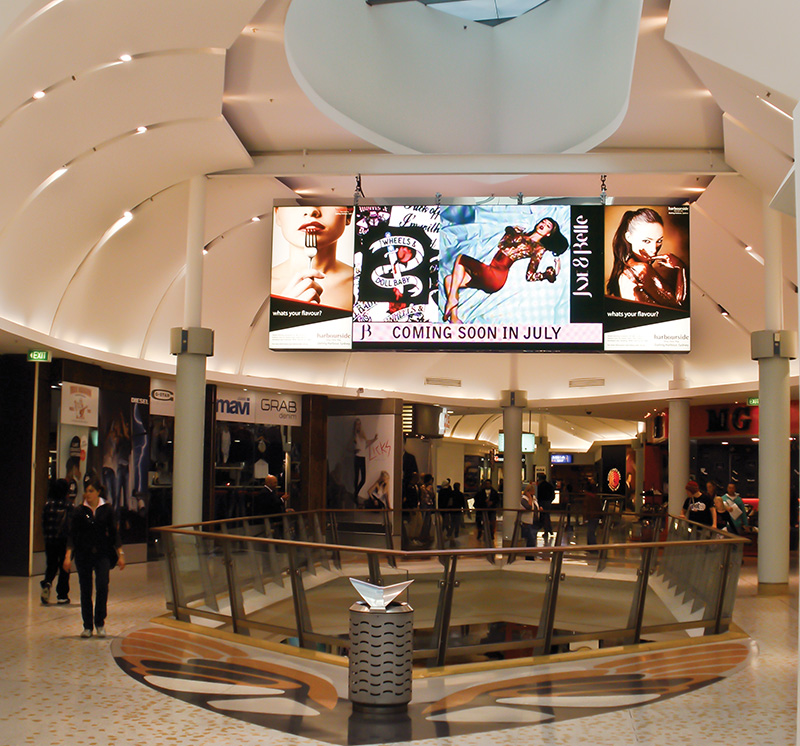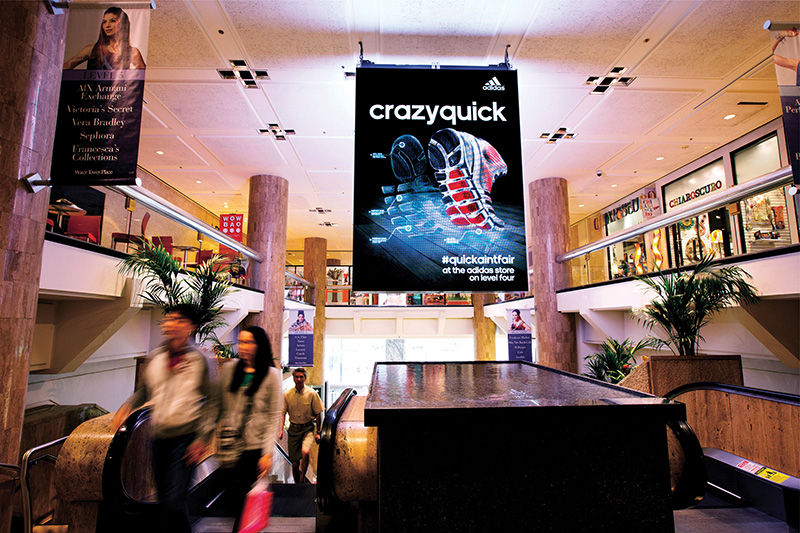Retailers investing in an omnichannel marketing approach must consider the digital medium.
By Ed Wasserman
Since the arrival of online shopping, headlines have predicted the slow departure of the traditional retail business model. Rather than throw in the towel, savvy retailers have adapted to and embraced the e-commerce evolution. By creating a diverse retail marketing mix, retailers minimize the online impact on their in-store business.
Operating under the assumption that e-commerce can’t completely overtake the personal, customer experiences shopping centers provide, retail operators are redoubling their efforts to improve their brick-and-mortar environments. Increasingly, much of this ‘improving’ includes the implementation of a digital strategy throughout the mall and/or network of mall locations. The challenge many face is ensuring consistent and quality message integration across all the different marketing channels where they do business with shoppers.
Consumers today expect a fresh, convenient and modern shopping experience. Digital signage technology is just one piece of the marketing pie that can enhance the overall experience for shoppers. Retail operators who may have hesitated at investing into digital media quickly realize the benefits outweigh the initial cost. To help balance the high up-front price tag, many retailers take the ‘phase’ approach: implementing key locations first, then tweaking the product or process when rolling it out to other stores and/or locations. The point is that retailers are always looking for new ideas, new digital platforms and new technology for brand and store messaging — in addition to entertaining and engaging customers while they shop.
The following takes a look at the types of digital signage shopping malls are implementing and adapting into their environments and how they are being used. It also highlights the critical importance of developing a comprehensive content strategy when rolling out any digital display network.
 Retail Digital Signage
Retail Digital Signage
Dynamic digital screens in the shopping landscape takes on many forms. Creative mixtures of LED and LCD technology appear wherever there is an open space to do so. Digital signage is found on curved walls, on street furniture, inside domes, along structures, above food courts, up elevators, hanging in front of windows, popping up on interactive kiosks and on in-store digital screens. This technology is even helping turn building façades into dynamic communication mediums without concealing the unique architecture beneath it.
How and why is all of this happening? Video technology gets brighter and better with each passing year. As the demand for the technology within in the retail space increases, so does the competition between shopping centers. Once a handful of industry-leading shopping developers began rolling out their own digital video solutions, others followed suit. In addition, as costs become more affordable, display manufacturers are producing evolving products that are lighter, thinner, brighter, and use less power than their predecessors. Many are designing dynamic digital signage products specifically for the retail market’s needs in mind.
One phenomenon is the growth of large-format hanging, indoor LED video displays. Several solutions have been developed over the course of the past 4 to 5 years and are quickly becoming the market standard for multiple digital mall networks. Some hoist, hang and rotate above mall center courts, while others are stationary and appear along corridors or open wall space. Their unique features allow them to act as a backdrop for fashion shows, live in-mall concerts, live TV broadcasts, video gaming competitions or, as of late, tie-in to interactive or social media providing coupons, discounts and more.
Digital is also increasing its presence outside shopping mall walls. Whether it’s an LED billboard marquee, digital way-finding signage, or designed into the outer architecture, LEDs are creatively used throughout retail environments. Retail is embracing digital signage’s power and flexibility and those that reach for the cutting-edge will benefit the most.
 LED vs. LCD
LED vs. LCD
When assessing technology, it’s essential that retail marketers educate themselves on key feature differences between LED & LCD screens. Depending on the application and audience viewing distance, one is usually a better choice over the other. Generally, LED displays are 3 to 5 times brighter than LCD screens for equal or less power consumption. So if your application is within an environment where ambient light or sunlight is frequent, an LCD screen may not be the ideal choice as they can appear washed out. The vast majority of LED displays are designed to last more than 100,000 hours. That’s 3 to 4 times longer than a typical LCD, offering a better return on investment. But if a retailer plans to update technology relatively often, a display’s prime operational lifetime may not hold much weight in the decision-making process. In demanding bright outdoor environments, LCD technology can experience a shorter lifetime and appear washed out when faced with direct sunlight.
Depending on your goals and where your digital displays will live and operate, there are plenty of factors to evaluate when choosing the appropriate retail digital signage solution.
Developing a Content Strategy
When it comes to digital signage, most people tend to focus on the ‘cool factor’ or immense scale of these dynamic screens. Of course this is incredibly important, but equally vital is building a solid, well thought out content strategy. Without that, digital signage can quickly become insignificant. If you have a solid content strategy, you’ll enhance the display’s or network of display’s impact. The key is developing a digital signage strategy that fosters a personalized and engaging shopping experience that cannot be found on a desktop or smartphone.
With new technology, the fact remains that it’s only as good as the content it features. What should one consider when implementing a content strategy to a network of digital retail signage? One key concern is grasping the array of possibilities they offer, then gaining an understanding of what goals you want your digital displays to achieve. Do you want to increase revenue at the point of sale? Do you want to focus on increasing ‘hang out’ time in the store and/or mall through entertaining and engaging your customers? Ensuring the message content is fresh, unique and engaging to shoppers is imperative.
Digital signage presents an incredible opportunity to enhance and reinforce brands and messaging, launch products, create event buzz and inform shoppers of specials directly at the point of sale. Retailers take advantage of many opportunities to interact and engage customers via digital signage. Content examples include real-time data that features the latest in entertainment news, fashion, beauty tips or health trends. Customized content takes it a step further, highlighting local events at the mall or tenant promotions. Higher-end engagement examples include text-to-win contests, pic-to-screen moments, mobile games, QR codes, social media, trivia games, or fun and interesting facts for shoppers. Engagement programs can be optimized to take advantage of data capturing, sound interactivity, gaze tracking, and more. The challenging part is keeping messages current, promotions distinctive and images provocative.
Conclusion
Digital signage has become a fixture ingredient within a retailer’s marketing mix. Throughout the world, retailers are integrating on-premise digital signage into their overall marketing strategies. Those still considering, their next step is choosing a qualified partner that is experienced in rolling out digital signage and/or network of displays. Do they understand your needs and goals? Do they design, manufacture and deliver a quality, cutting-edge product and offer proper software training, creative content resources, along with long term preventative maintenance and service? A partner with these capabilities is an essential part of a successful digital video display network rollout to enhance and improve the entire retail shopping experience.
— Ed Wasserman is special projects director with Daktronics. Email him at [email protected].
